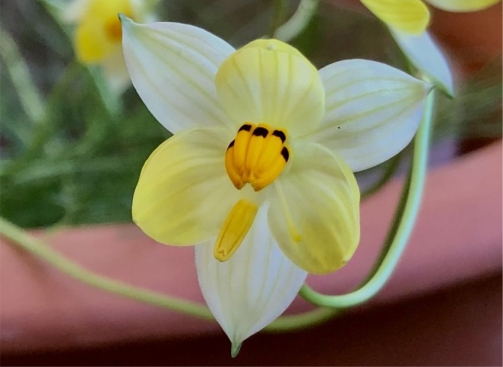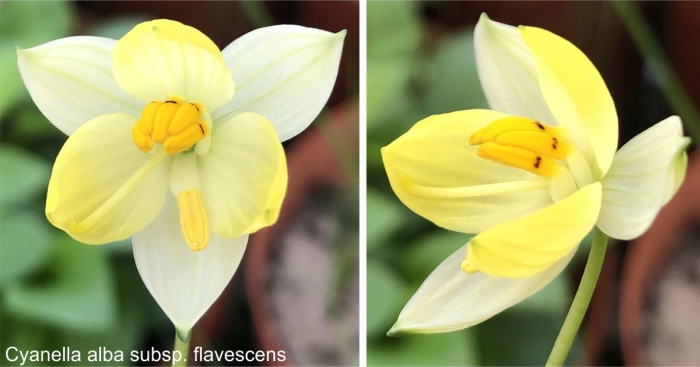Cyanella alba
Cyanella alba L.f.
Family: Tecophilaeaceae
Common names: white lady's-hand, white cyanella (Eng.); toe-toe-uintjie (Afr.)
Introduction
Cyanella alba has striking bright yellow or white, hooded flowers and is a winter-growing geophyte from the Mediterranean climate regions of South Africa.

Description
Description
Cyanella alba is a perennial herb, 80–200 mm high, that flowers in spring and early summer and has an annual fibrous corm with concentric layers. The leaves are grass-like in appearance. The flowers are white, pale yellow or pale pink and slightly fragrant. The filaments of the stamens are white, thick, and strong, and the anthers are dark yellow and hard. Upper stamens are the five of six stamens that emerge at roughly right angles to the tepal bases. Their anthers are sometimes fused, arcuate, forming a hood-like structure at the top of the flower. The back of this hood is sometimes marked by five conspicuous black spots, one on each anther connective. The sixth stamen, known as the lower stamen, is declined and nearly parallel to one of the tepals.

Three subspecies are recognized: Cyanella alba L.f. subsp. alba, Cyanella alba L.f. subsp. minor J.C.Manning and Cyanella alba L.f. subsp. flavescens J.C.Manning.
The subspecies alba (Bokkeveld White Lady’s-hand) has white or pale pink flowers with uniformly yellow anthers, on long pedicels up to 200 mm long, and 3 to 9 flowers per plant.
The subspecies minor (Mini or Tanqua White Lady’s-hand) has similar flowers to subspecies alba, but with shorter pedicels, usually less than 100 mm long, and is a smaller plant with only 1 to 3 flowers per plant.
The subspecies flavescens (Yellow or Biedouw White Lady’s-hand) has pale yellow flowers, sometimes the outer tepals are white, and the upper anthers are marked with a black spot near the base.

Conservation Status
Status
The Red List of South African plants assessed Cyanella alba as not threatened in the wild in 2009, when it was given the status of Least Concern (LC). Three subspecies are now recognized and the Red List status of each was reassessed as follows: the subsp. minor is Vulnerable (VU), subsp. alba is also Vulnerable (VU) and subsp. flavescens is classified Rare but is not threatened. Although Cyanella alba is locally common where it occurs, it has a restricted range and has lost, and continues to lose habitat due to crop farming, overgrazing and invasive alien plants.
Distribution and habitat
Distribution description
The species is found in the Western Cape’s western mountains, in the Bokkeveld Escarpment around Nieuwoudtville to Botterkloof, in the Cedarberg, Biedouw and Olifants River valleys, and at the base of the Swartruggens in the southern Tanqua Karoo. These three areas of occurrence also correspond to the distribution of the three recognized subspecies. Cyanella alba grows only on clay soils in renosterveld shrubland.

Derivation of name and historical aspects
History
The genus name Cyanella is derived from the Greek kyanos, which means ‘blue’, and -ella, the diminutive, in other words ‘little blue’, referring to the type species described that has small flowers, although Cyanella alba has yellow and white flowers. The specific epithet alba is a unisex name of Latin origin meaning ‘white’ and refers particularly to the flower colour of this species.
Tecophilaeaceae or the Cyanella family, in the order Asparagales, was previously classified as Liliaceae. It consists of 8 genera and approximately 25 species. Although there is one genus with one species from North America (California), the majority of them are found in South America and South Africa. Cyanella is South Africa’s only significant ornamental genus in this family.
Tecophilaeaceae evolved during the Late Cretaceous period and now has a disjunct distribution between Chile, California and mainland Africa, having colonized three of the world’s five Mediterranean-climate regions (the family is not found in the Mediterranean Basin or south-west Australia). The species richness in this family is unevenly distributed, with Chile (8 species) and the Greater Cape region (10 species) having the most diversity, but only 3 species in tropical Africa and 1 in California.

Ecology
Ecology
Cyanella alba is pollinated by the large solitary bees of the family Apidae: Anthophoridae, who are their specialist pollinators, and release a specific frequency that causes the anther to reverberate and expel pollen. This is termed buzz pollination.

Uses
Use
The edible corms can be consumed raw, roasted, or boiled in milk and are nutrient-rich due to their high protein and low moisture content. The roasted corms of several Cyanella species were consumed by various indigenous and early settler populations, who called them raaptolle. The Afrikaans words for turnip and spinning top, respectively, are raap and tol. Raaptol describes the corm’s shape.
Horticulturally, it thrives in well-drained soils in rock gardens or as a potted plant, with water in autumn, winter and spring, and a dry summer.

Growing Cyanella alba
Grow
Cyanella alba can be propagated in two ways, by seed and by the separation of corms.
The seeds are sown in deep seed trays in the autumn (March), preferably in a medium made up of equal parts industrial sand or river sand and fine compost or loam. To avoid crowding and provide enough space for the growth of rootstocks, seeds should be sown thinly. Pure sand should be lightly sprinkled over them. The sowing medium should always be kept moist as the seeds should germinate in 3–4 weeks. During their first growing season, the seeds must be positioned in a semi-shaded location. They must then wait until their second growing season to be potted up.
The corms can be lifted and the cormels/cormlets separated in the summer to increase the stock after the foliage has died back. The cormels/cormlets can then be planted in a sharply draining medium, such as a mixture of coarse river sand, industrial (silica) sand, and fine compost, and they should receive regular, heavy wettings during the winter-growing and spring-flowering seasons.
References
- Du PLessis, N.M. & Duncan, G.D. 1989. Bulbous plants of southern Africa. Tafelberg, Cape Town.
- Dulberger, R & Ornduff, R.1980. Floral morphology and reproductive biology of four species of Cyanella (Tecophilaeaceae). The New Phytologist 86(1): 45–56.
- Jeppe, B. & Duncan, G.D. 1989. Spring and winter flowering bulbs of the Cape. Oxford University Press, Cape Town.
- Manning, J.C. & Goldblatt P. 2012. A revision of Tecophilaeaceae subfam. Tecophilaeoideae in Africa. Bothalia 42(1): 21–41.
- Raimondo, D., Von Staden, L., Foden, W., Victor, J.E., Helme, N.A., Turner, R.C., Kamundi, D.A. & Manyama, P.A. (eds) 2009. Red list of South African plants. Strelitzia 25. South African National Biodiversity Institute, Pretoria.
- Stearn, W. 2002. Stearn's dictionary of plant names for gardeners. Timber Press, Portland, Oregon.
- Harris, S. 2020. Cyanella hyacinthoides Royen ex L. (Tecophilaeaceae). PlantZAfrica. Online. http://pza.sanbi.org/cyanella-hyacinthoides.
- Riegel, F. 2019. Observation of Cyanella alba subsp. alba, Hantam NBG. iNaturalist. https://www.inaturalist.org/observations/35707530.
- Scott. G. 1991. A revision of Cyanella (Tecophilaeaceae) excluding C. amboensis South African Journal of Botany 57(1): 34–54
- Von Staden, L. 2015. Cyanella alba L.f. subsp. flavescens J.C.Manning. National Assessment: Red List of South African Plants version 2020.1. Accessed on 2022/08/01.
- Von Staden, L. 2015. Cyanella alba L.f. subsp. minor J.C.Manning. National Assessment: Red List of South African Plants version 2020.1. Accessed on 2022/08/01.
- Von Staden, L. 2015. Cyanella alba L.f. subsp. alba. National Assessment: Red List of South African Plants version 2020.1. Accessed on 2022/08/01.
Credits
Sithandokuhle Wendy Ngcongo
Kirstenbosch National Botanical Garden
August 2022
Acknowledgements: additional images by Felix Riegel.
Plant Attributes:
Plant Type: Bulb
SA Distribution: Northern Cape, Western Cape
Soil type: Clay
Flowering season: Spring, Winter
PH: Acid, Neutral
Flower colour: White, Yellow
Aspect: Full Sun
Gardening skill: Average
Special Features:
Horticultural zones








Rate this article
Article well written and informative
Rate this plant
Is this an interesting plant?
Login to add your Comment
Back to topNot registered yet? Click here to register.